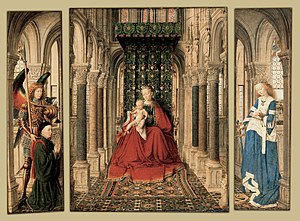art.wikisort.org - Pittura
Il Trittico di Dresda, chiamato anche Trittico Giustiniani, è un dipinto olio su tavola di Jan van Eyck, commissionato dalla famiglia di mercanti genovesi Giustiniani[1] e databile al 1437 e conservato nella Gemäldegalerie Alte Meister di Dresda.
| Trittico di Dresda | |
|---|---|
 | |
| Autore | Jan van Eyck |
| Data | 1437 |
| Tecnica | olio su tavola |
| Dimensioni | 27,5×37,5 cm |
| Ubicazione | Gemäldegalerie Alte Meister, Dresda |
Descrizione
Il piccolo altare portatile mostra al centro Maria con il bambino Gesù, sulla sinistra San Michele e il donatore, mentre a destra si trova santa Caterina d'Alessandria. Il dipinto è chiudibile e sul retro delle ante è rappresentata l'Annunciazione in grisaille. La cornice marmorizzata è originale e reca iscrizioni all'interno.
La scena interna è ambientata in una chiesa romanica inondata dalla luce che proviene da più aperture. Ricchissima e variegata a seconda dei materiali è la resa dei dettagli, possibile solo con la tecnica della pittura a olio. Le numerose statue e i bassorilievi dipinti concorrono anche, col loro valore simbolico, a precisare il significato religioso dell'opera, soprattutto tramite riferimenti all'antico testamento.
In terra il pavimento, coperto da un prezioso tappeto turco, crea un suggestivo scorcio prospettico, che però è ben diverso da quello dei dipinti del Rinascimento italiano. La linea dell'orizzonte è infatti più alta (da ciò deriva l'effetto "avvolgente" del dipinto) e la scansione spaziale in profondità è più intuitiva che geometrica, infatti a ben notare i personaggi sono leggermente sovradimensionati rispetto all'architettura, anche se ciò non si percepisce a uno sguardo d'insieme.
Note
- Noëlle L.W. Streeton, Jan van Eyck’s Dresden Triptych: new evidence for the Giustiniani of Genoa in the Borromei ledger for Bruges, 1438, in Historians of Netherlandish Art, 2011.
Altri progetti
 Wikimedia Commons contiene immagini o altri file su Trittico di Dresda
Wikimedia Commons contiene immagini o altri file su Trittico di Dresda
Collegamenti esterni
- Staatliche Kunstsammlungen Dresda, su skd-dresden.de. URL consultato il 4 agosto 2009 (archiviato dall'url originale il 16 luglio 2006).
На других языках
[de] Dresdner Marienaltar
Der Dresdner Marienaltar ist ein kleinformatiges Triptychon von Jan van Eyck. Das Werk aus dem Jahr 1437, gemalt mit Öl auf Eichenholz, befindet sich in der Gemäldegalerie Alte Meister in Dresden. Es zeigt in geöffnetem Zustand eine Thronende Madonna und geschlossen eine Verkündigungsszene in sog. Grisaillemalerei.[en] Dresden Triptych
The Dresden Triptych (or Virgin and Child with St. Michael and St. Catherine and a Donor, or Triptych of the Virgin and Child) is a very small hinged-triptych altarpiece by the Early Netherlandish painter Jan van Eyck. It consists of five individual panel paintings: a central inner panel, and two double-sided wings. It is signed and dated 1437, and in a permanent collection of the Gemäldegalerie Alte Meister, Dresden, with the panels still in their original frames. The only extant triptych attributed to van Eyck, and the only non-portrait signed with his personal motto, ALC IXH XAN ("I Do as I Can"),[a 1] the triptych can be placed at the midpoint of his known works. It echoes a number of the motifs of his earlier works while marking an advancement in his ability in handling depth of space, and establishes iconographic elements of Marian portraiture that were to become widespread by the latter half of the 15th century. Elisabeth Dhanens describes it as "the most charming, delicate and appealing work by Jan van Eyck that has survived".[1][es] Tríptico de Dresde
El Tríptico de Dresde (o La Virgen y el Niño con San Miguel y Santa Catalina y un Donante, o Tríptico de la Virgen y el Niño) es un retablo tríptico muy pequeño realizado por el pintor del primitivo flamenco Jan van Eyck. Consta de cinco paneles pintados individuales: una tabla interior central, y dos alas laterales pintadas por ambas caras. Está firmado y fechado en 1437, y se encuentra en la colección permanente de la Gemäldegalerie Alte Meister, en Dresde. Las tablas aún se encuentran en sus marcos originales. Es el único tríptico existente completo atribuido a van Eyck, y el único en no ser un retrato y estar firmado con su lema personal, ALC IXH XAN ("Hago como Puedo"). Su producción se dio a la mitad de su carrera.[a 1] Repite una serie de motivos de sus trabajos más tempranos mientras marca un progreso en su capacidad de manejar la profundidad espacial, y establece elementos iconográficos del arte mariano que se propagarían en la segunda mitad del siglo XV. Elisabeth Dhanens lo describe como "el más encantador, delicado y atractivo trabajo de Jan van Eyck que ha sobrevivido".[1][fr] Triptyque de Dresde
Le Triptyque de Dresde, en allemand : Dresden Marienaltar, ou Triptyque Giustiniani, est un petit triptyque réalisé par le peintre primitif flamand Jan van Eyck vers 1437. Il est exposé aujourd'hui au Gemäldegalerie Alte Meister de Dresde. Avant Dresde, l’œuvre faisait partie de la collection Jabach.- [it] Trittico di Dresda
Другой контент может иметь иную лицензию. Перед использованием материалов сайта WikiSort.org внимательно изучите правила лицензирования конкретных элементов наполнения сайта.
WikiSort.org - проект по пересортировке и дополнению контента Википедии